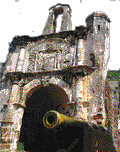A Brief History of Melaka
Melaka or previously known as 'Malacca' is one of the thirteen states that belongs to Malaysia and it is located 2 degrees north of the equator by the shore of the Straits of Melaka between Singapore to its south and Kuala Lumpur, the capital of Malaysia to its north. The State occupies an area of about 1650 sq km only and the population in 1991 was recorded as 504,502.
The Historical City of Melaka hosts a wide and interesting collection of a diversified culture, a unique blend of Eastern and Western architecture and a rich background of history. Melaka was once the cradle of modern civilisation in a multi-rational society and the center of trade in the region that was even envied by the Europeans. Now it is one of the most popular tour destinations in Malaysia.
According to legends, Melaka was founded by a prince known as Parameswara. From a dying ancient kingdom of Srivijaya, Parameswara came to Tumasik (Singapore), killed the ruler who paid tribute to Siam and reigned there for five years until the Siamese drove him out. It was told that while in exile, Parameswara chose Melaka as his new kingdom because here, near the hill and along the river bank, a small but aggressive white mousedeer caught his attention when the mousedeer so intimidated his hunting dogs that they turned and fell into the water. The place where the weak can triumph over the strong, Parameswara decided, would be a good location for a settlement. Soon traders began to call to its port and the little settlement prospered under many generations of Sultans.
Word on the importance of Melaka as the center for trade for the whole eastern part of Asia and the gateway to the spice islands of the East Indies soon reached the ears of the Portuguese. In 1509, a fleet commanded by Dom Diogo Lopez de Sequeira was sent to investigate Melaka and to request the Sultan to allow the Portuguese to trade there. However, the Sultan was persuaded by local traders to refuse permission. A party of Portuguese who were ashore were suddenly seized and imprisoned, Sequeira then withdrew his fleet.
In 1511 Afonso d'Albuquerque who was Viceroy of all the Portuguese in the East, sailed for Melaka with a fleet of sixteen ships and took over the city. The Sultan and his Malay chiefs fled from the city, to which they were never able to return. d'Albuquerque immediately build a great stone castle by the bridge, to which the name A' Famosa (the Famous) was given. It was to prove strong enough to resist all attacks from foes during the one hundred and thirty years that the Portuguese held Melaka.
When the Dutch decided to capture Melaka, the siege began in June 1640 and took six months before the Dutch and their allies captured the city at the beginning of 1641. At the time of the attack, the Dutch alliance with Johor saw a combined fleet of 1,500 Dutch men, 1,500 Malays, 12 Dutch ships, 6 sloops and 40 Johor vessels lay waiting off the Melaka port. The siege was extremely difficult and nearly 1,500 Dutch men lost their lives on the shores of Melaka. On 14th January 1641, the Dutch commander Wilmsoon Kartekoe ordered the final assault on the fortress town. The Dutch commander offered to the Portuguese honourable terms of surrender to the already dying Portuguese commander, Dom Manuel de Sousa Coutinho. The generous terms were accepted and only two days later the Portuguese commander died. He was buried by the Dutch in Melaka with military honours.
After this, the Dutch ruled Melaka for more than one hundred and fifty years. From their new base in Melaka, they tried to control the trade passing through the Straits of Melaka and the export of tin from Malaya (the old name of Malaysia). The Stadthuys or government offices, the church and several other old houses which were built by the Dutch can still be seen in the Melaka town today.
Melaka was controlled by Great Britain from 1795 to 1802 and again from 1811 to 1818. After a brief spell of renewed Dutch control, the British acquired Melaka again in 1824, incorporating it into the Straits Settlements in 1826 with Penang and Singapore, from which it became part of the Federation of Malaya and later Malaysia.
Malaysia obtained independence from the British rule on 31st August 1957. Since Melaka was the root of establishment of the country, the first Prime Minister of Malaysia thought it was appropriate to announce the news of independence first in Melaka.
Now, the people of Melaka are still made up of a rich ethnic variety of Malays, Chinese, Indians and Eurasians who are descendants of the Portuguese, Dutch and English.
(By Dennis DeWitt)
 |
|
 Recommended further
reading materials for the above topic:
Recommended further
reading materials for the above topic:
- Old Malacca by Sarina Hayes Hoyt
(This excelent book contains concise information and interesting facts on
the history of Melaka (previously Malacca), including pictures, tracing its
beginings from a humble fishing village through the Portuguese, Dutch and
English colonial era.)
Or just click at the below book title to see how to purchase the book via the internet from our affiliated electronic bookshop :
|
|
|